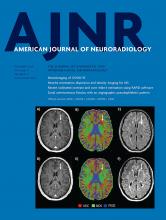Index by author
Dobashi, Y.
- EDITOR'S CHOICENeurointerventionYou have accessEndovascular Cerebral Venous Sinus Imaging with Optical Coherence TomographyC.R. Pasarikovski, J.C. Ku, J. Keith, J. Ramjist, Y. Dobashi, S.M. Priola, L. da Costa and V.X.D. YangAmerican Journal of Neuroradiology December 2020, 41 (12) 2292-2297; DOI: https://doi.org/10.3174/ajnr.A6909
Endovascular optical coherence tomography imaging was feasible in this preclinical animal study. Adoption of this imaging technique in the human cerebral venous sinus could aid in the diagnosis, treatment, and understanding of the pathophysiology of various diseases of the sinus.
Dorn, F.
- NeurointerventionYou have accessConsiderations for Antiplatelet Management of Carotid Stenting in the Setting of Mechanical Thrombectomy: A Delphi Consensus StatementM. Goyal, S. Yoshimura, G. Milot, J. Fiehler, M. Jayaraman, F. Dorn, A. Taylor, J. Liu, F. Albuquerque, M.E. Jensen, R. Nogueira, J.F. Fraser, R. Chapot, L. Thibault, C. Majoie, P. Yang, N. Sakai, D. Kallmes, K. Orlov, A. Arthur, P. Brouwer and J.M. OspelAmerican Journal of Neuroradiology December 2020, 41 (12) 2274-2279; DOI: https://doi.org/10.3174/ajnr.A6888
Doshi, A.
- Adult BrainOpen AccessNAA is a Marker of Disability in Secondary-Progressive MS: A Proton MR Spectroscopic Imaging StudyB.S. Solanky, N.A. John, F. DeAngelis, J. Stutters, F. Prados, T. Schneider, R.A. Parker, C.J. Weir, A. Monteverdi, D. Plantone, A. Doshi, D. MacManus, I. Marshall, F. Barkhof, C.A.M. Gandini Wheeler-Kingshott, J. Chataway and for the MS-SMART InvestigatorsAmerican Journal of Neuroradiology December 2020, 41 (12) 2209-2218; DOI: https://doi.org/10.3174/ajnr.A6809
Dowd, C.F.
- EDITOR'S CHOICEAdult BrainOpen AccessRecent Administration of Iodinated Contrast Renders Core Infarct Estimation Inaccurate Using RAPID SoftwareA.Z. Copelan, E.R. Smith, G.T. Drocton, K.H. Narsinh, D. Murph, R.S. Khangura, Z.J. Hartley, A.A. Abla, W.P. Dillon, C.F. Dowd, R.T. Higashida, V.V. Halbach, S.W. Hetts, D.L. Cooke, K. Keenan, J. Nelson, D. Mccoy, M. Ciano and M.R. AmansAmerican Journal of Neuroradiology December 2020, 41 (12) 2235-2242; DOI: https://doi.org/10.3174/ajnr.A6908
Patients who received IV iodinated contrast in proximity (<8 hours) to CTA/CTP as part of a separate imaging study had a much higher likelihood of core infarct underestimation with RAPID software compared with contrast-naive patients. Over-reliance on RAPID postprocessing for treatment disposition of patients with extended window emergent large-vessel occlusion should be avoided, particularly in cases with recent IV contrast administration.
- NeurointerventionOpen AccessInterrater Reliability in the Measurement of Flow Characteristics on Color-Coded Quantitative DSA of Brain AVMsK.H Narsinh, K. Mueller, J. Nelson, J. Massachi, D.C. Murph, A.Z. Copelan, S.W. Hetts, V.V. Halbach, R.T. Higashida, A.A. Abla, M.R. Amans, C.F. Dowd, H. Kim and D.L. CookeAmerican Journal of Neuroradiology December 2020, 41 (12) 2303-2310; DOI: https://doi.org/10.3174/ajnr.A6846
Drocton, G.T.
- EDITOR'S CHOICEAdult BrainOpen AccessRecent Administration of Iodinated Contrast Renders Core Infarct Estimation Inaccurate Using RAPID SoftwareA.Z. Copelan, E.R. Smith, G.T. Drocton, K.H. Narsinh, D. Murph, R.S. Khangura, Z.J. Hartley, A.A. Abla, W.P. Dillon, C.F. Dowd, R.T. Higashida, V.V. Halbach, S.W. Hetts, D.L. Cooke, K. Keenan, J. Nelson, D. Mccoy, M. Ciano and M.R. AmansAmerican Journal of Neuroradiology December 2020, 41 (12) 2235-2242; DOI: https://doi.org/10.3174/ajnr.A6908
Patients who received IV iodinated contrast in proximity (<8 hours) to CTA/CTP as part of a separate imaging study had a much higher likelihood of core infarct underestimation with RAPID software compared with contrast-naive patients. Over-reliance on RAPID postprocessing for treatment disposition of patients with extended window emergent large-vessel occlusion should be avoided, particularly in cases with recent IV contrast administration.
Dunn, J.
- PediatricsOpen AccessDesign of 3D-Printed Nasopharyngeal Swabs for Children is Enabled by Radiologic ImagingZ. Starosolski, P. Admane, J. Dunn, B. Kaziny, T.A.G.M. Huisman and A. AnnapragadaAmerican Journal of Neuroradiology December 2020, 41 (12) 2345-2347; DOI: https://doi.org/10.3174/ajnr.A6794
Eckel, L.J.
- Open AccessImaging Review of Paraneoplastic Neurologic SyndromesA.A. Madhavan, C.M. Carr, P.P. Morris, E.P. Flanagan, A.L. Kotsenas, C.H. Hunt, L.J. Eckel, E.P. Lindell and F.E. DiehnAmerican Journal of Neuroradiology December 2020, 41 (12) 2176-2187; DOI: https://doi.org/10.3174/ajnr.A6815
Elhammady, M.S.
- FELLOWS' JOURNAL CLUBNeurointerventionOpen AccessCharacteristics of Large-Vessel Occlusion Associated with COVID-19 and Ischemic StrokeS. John, P. Kesav, V.A. Mifsud, B. Piechowski-Jozwiak, J. Dibu, A. Bayrlee, H. Elkambergy, F. Roser, M.S. Elhammady, K. Zahra and S.I. HussainAmerican Journal of Neuroradiology December 2020, 41 (12) 2263-2268; DOI: https://doi.org/10.3174/ajnr.A6799
Consecutive ischemic stroke and TIA admissions (COVID and non-COVID) to the authors' hospital during a 10-week period from March 1 to May 10, 2020 were collected and compared with data from the same time period in 2019. Among 20 patients with COVID-19 and acute ischemic stroke, 15 (75%) had large-vessel occlusion. These patients were young (mean age, 46.5 years), male (93%), without major burden of traditional cardiovascular risk factors, and had a severe stroke presentation. Large vessel occlusions were observed in multiple vessels (40%), uncommonly affected vessels, and atypical locations with a large thrombus burden.
Elkambergy, H.
- FELLOWS' JOURNAL CLUBNeurointerventionOpen AccessCharacteristics of Large-Vessel Occlusion Associated with COVID-19 and Ischemic StrokeS. John, P. Kesav, V.A. Mifsud, B. Piechowski-Jozwiak, J. Dibu, A. Bayrlee, H. Elkambergy, F. Roser, M.S. Elhammady, K. Zahra and S.I. HussainAmerican Journal of Neuroradiology December 2020, 41 (12) 2263-2268; DOI: https://doi.org/10.3174/ajnr.A6799
Consecutive ischemic stroke and TIA admissions (COVID and non-COVID) to the authors' hospital during a 10-week period from March 1 to May 10, 2020 were collected and compared with data from the same time period in 2019. Among 20 patients with COVID-19 and acute ischemic stroke, 15 (75%) had large-vessel occlusion. These patients were young (mean age, 46.5 years), male (93%), without major burden of traditional cardiovascular risk factors, and had a severe stroke presentation. Large vessel occlusions were observed in multiple vessels (40%), uncommonly affected vessels, and atypical locations with a large thrombus burden.
Esenwa, C.
- NeurointerventionOpen AccessThe Impact of COVID-19 on Emergent Large-Vessel Occlusion: Delayed Presentation Confirmed by ASPECTSD.J. Altschul, N. Haranhalli, C. Esenwa, S.R. Unda, R. de La Garza Ramos, J. Dardick, J. Fernandez-Torres, A. Toma, D. Labovitz, N. Cheng, S.K. Lee, A. Brook and R. ZampolinAmerican Journal of Neuroradiology December 2020, 41 (12) 2271-2273; DOI: https://doi.org/10.3174/ajnr.A6800








